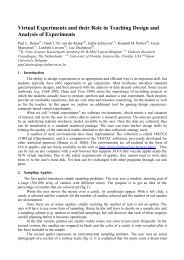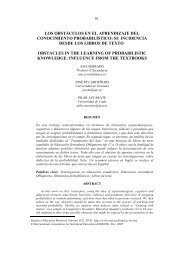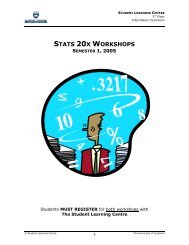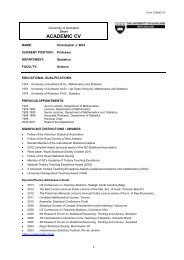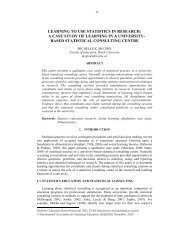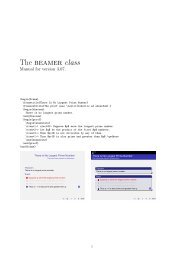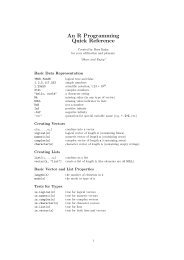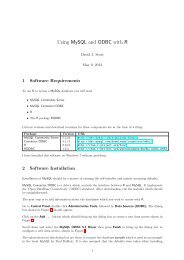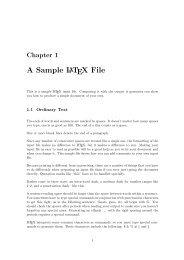modeling the growth of students' covariational reasoning during an ...
modeling the growth of students' covariational reasoning during an ...
modeling the growth of students' covariational reasoning during an ...
You also want an ePaper? Increase the reach of your titles
YUMPU automatically turns print PDFs into web optimized ePapers that Google loves.
10<br />
judgments, but ra<strong>the</strong>r <strong>the</strong>y have trouble decoding <strong>the</strong> ways in which <strong>the</strong>se relationships<br />
are displayed (e.g., scatterplots or contingency tables).<br />
In a study <strong>of</strong> younger children, Moritz (2004) had students tr<strong>an</strong>slate verbal statements<br />
to graphs <strong>an</strong>d also tr<strong>an</strong>slate a scatterplot into a verbal statement. The students were also<br />
given a written survey that included six or seven open-ended tasks involving familiar<br />
variables. The variables were chosen so that students would expect a positive covariation,<br />
but <strong>the</strong> data given in <strong>the</strong> task represented a negative covariation. Moritz found m<strong>an</strong>y <strong>of</strong><br />
<strong>the</strong> same student difficulties as o<strong>the</strong>r studies have revealed: that students <strong>of</strong>ten focused on<br />
isolated data points ra<strong>the</strong>r th<strong>an</strong> on <strong>the</strong> global data set (e.g., Ben-Zvi & Arcavi, 2001); that<br />
students would <strong>of</strong>ten focus on a single variable ra<strong>the</strong>r th<strong>an</strong> <strong>the</strong> bivariate data; <strong>an</strong>d that<br />
several students had trouble h<strong>an</strong>dling negative covariations when <strong>the</strong>y are contradictory<br />
to <strong>the</strong>ir prior beliefs.<br />
Two design experiments investigated <strong>the</strong> role <strong>of</strong> technology in helping students<br />
reason about bivariate data, <strong>an</strong>d how students differentiate between local <strong>an</strong>d global<br />
variation in bivariate data. Gravemeijer’s (2000) results suggested that students need <strong>an</strong><br />
idea <strong>of</strong> <strong>the</strong> global trend (prior expectation) <strong>an</strong>d that students have a hard time<br />
distinguishing between arbitrary <strong>an</strong>d structural covariation. He suggested that students<br />
examine <strong>an</strong>d compare several univariate data sets (time series) as <strong>an</strong> introduction to<br />
examining bivariate data.<br />
This approach was used by Cobb, McClain, <strong>an</strong>d Gravemeijer (2003) to help students<br />
view bivariate data as distributed in two-dimensional space, to see scatterplots as<br />
situational texts, <strong>an</strong>d to track <strong>the</strong> distribution <strong>of</strong> one variable across <strong>the</strong> o<strong>the</strong>r (sc<strong>an</strong><br />
vertically ra<strong>the</strong>r th<strong>an</strong> diagonally). Using <strong>the</strong> Minitools s<strong>of</strong>tware (Cobb, Gravemeijer,<br />
Bowers, & Doorm<strong>an</strong>, 1997) students examined <strong>the</strong> “vertical variation” across levels <strong>of</strong> x<br />
in graphs <strong>of</strong> bivariate data. Students were asked to compare differences in <strong>the</strong> distribution<br />
<strong>of</strong> <strong>the</strong> y-variable at different levels <strong>of</strong> <strong>the</strong> x-variable (see Figure 1).<br />
Figure 1. Minitools s<strong>of</strong>tware allows students to start looking at <strong>the</strong> local variation for<br />
different values on <strong>the</strong> x-axis in addition to <strong>the</strong> global trend<br />
The results <strong>of</strong> <strong>the</strong>ir study suggested that <strong>the</strong> shape <strong>of</strong> a distribution is a better place to<br />
start th<strong>an</strong> is variability <strong>an</strong>d that <strong>the</strong>re be a continued focus on relative density <strong>an</strong>d on <strong>the</strong><br />
shape <strong>of</strong> <strong>the</strong> data within vertical slices. They also suggested that <strong>an</strong> emphasis on shape<br />
could lead to a discussion <strong>of</strong> strength <strong>an</strong>d direction in a bivariate plot <strong>an</strong>d that <strong>the</strong> focus<br />
on vertical distribution could lead to a more intuitive idea <strong>of</strong> <strong>the</strong> line <strong>of</strong> best fit.



